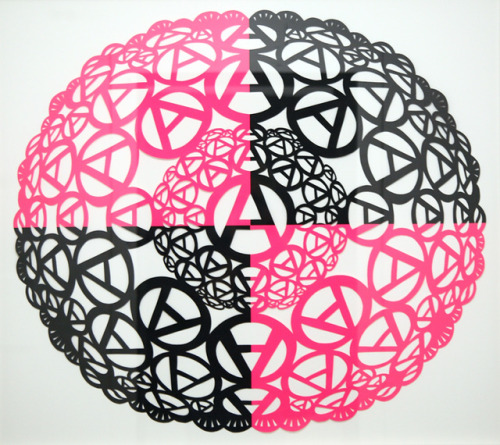Dikeou Superstars: Simon Periton

The Dikeou Collection is housed in a historic building in the heart of downtown Denver. Known as the Colorado Building, it was originally constructed in the early 1890s and served as a department store and later was converted into an office building with a diverse group of tenants. One of those tenants was Morris Jewelers, which could have likely occupied a suite on the 5th floor where Dikeou Collection is located because there is a large, walk-in safe which is now home to Simon Periton’s Radiant Anarchy Doily. Created in 1998, Radiant Anarchy Doily is a brilliant representation of Periton’s dexterous papercutting abilities and personal perspective on popular culture. Periton’s three Barbed Wire Target cut outs, exhibited just outside of the walk-in safe, again serve as a nod to the artist’s interest in the intersections between art, history, and popular culture. Beyond his intended references, Periton’s grouping of works at Dikeou Collection magnify the historic elements of the space where they exist and contribute to the already rich narrative of the Colorado Building and the artwork within.

Frieze Magazine featured Radiant Anarchy Doily on the cover of its 1998 September-October issue. Writer Michelle Grabner describes the work as “thin, beautiful and exact. The concentric rings of ‘A’s which comprise its doily pattern have as much revolutionary promise as a capital A inked out on the back of a teenager’s notebook, suggesting neither a spoof nor a call to arms.” The contrasting pink and black colors reaffirm this inherent contradiction within the anarchy symbol, as does the highly controlled pattern of the doily itself and its history as a feminine, domestic item. This work’s placement within the safe, symbolic of capitalism and monetary regulation, adds another layer to Pertion’s roguish dualism.

Barbed Wire Target I, III and IV allude to Jasper Johns’ seminal target paintings/assemblages from the mid-1950s. In her curatorial statement Devon Dikeou observes , that Periton “cleverly attacks the idea Johns addressed: formal space and color in terms of literal recognition (of the target as recognizable icon) and formal resolutions of space and color as one sees them. Periton’s iconographic use of Pop imagery, one that bespeaks a certain youth and culture, fuses image and space, whereas Johns meant to defuse it through the use of images that provoked no meaning.” Additionally, while a target is something to be aimed for, to be struck, and represents a specific goal, barbed wire is a defensive tool meant to prevent intrusion. The metallic foil from which these are made is shiny and attractive, and draw the viewer toward these symbols of danger and exclusion. In a sly curatorial quip, the targets are exhibited adjacent to Vik Muniz’ Milan: Last Supper, extending their symbolism into religious territory as they become references to Christ’s crown of thorns.
Periton’s astonishingly precise cut outs have earned him the title “punkish maestro of the scalpel,” and they were published for the first time anywhere in zingmagazine issue 12 . In his most recent exhibition at New Art Centre in Roche Court, UK, Periton created sculptural renditions of Radiant Anarchy Doily and the Barbed Wire Targets out of cardboard. By reconfiguring their structure and materiality, Periton continues to give new meaning to these works and the symbols upon which they are built.
-Hayley Richardson
